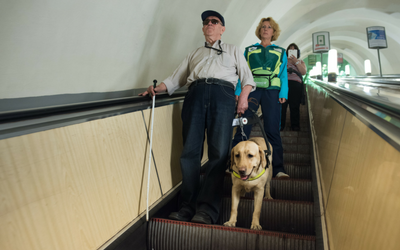
You’ve probably seen them at the mall, in the grocery store, or on the street. Perhaps you’ve seen fully trained service dogs assisting their owners by guiding them through stores or crossing a road.
Aug. 1-7 marks International Assistance Dog Week – a time to recognize assistance dogs and their puppy raisers and trainers, and to help raise awareness and educate the public about assistance dogs.
Assistance dogs change the lives of people, by helping them in their day-to-day activities (such as going to school, working, cooking, shopping, vacationing, etc.) which many of take for granted.
Assistance dogs enable people to live independently while helping keep their owners safe as they negotiate public spaces, use public transportation, and navigate stairs, curbs, and doors.
Assistance dogs (also known as service or guide dogs) have been around for centuries. Evidence of dogs leading the blind goes as far back as 79 AD and can be seen on wall-paintings in Pompeii!
Following the First World War in Germany, men were returning home from the frontline blinded by poison gas. Dr. Stalling, a German doctor, got the idea to train dogs by coincidence. He left his dog with a blind patient, and upon his return, saw that his dog was watching out for the patient. Dr. Stalling began working on a program to train dogs as reliable assistance dogs for the blind. This program opened the door to train dogs far beyond their initial use as guides for the visually impaired.
Now dogs can act as aids for people with a wide range of disabilities and medical conditions.
Assistance dogs range from guide dogs for those who are visually impaired, hearing dogs for those who are hearing impaired, and service dogs for those with epilepsy (detecting, alerting, or responding to seizures). Some service dogs work with veterans who have post-traumatic stress disorder (PTSD) as well as other conditions after active duty. Some dogs work with those who live with conditions like autism and Down syndrome.
Dogs that are well-suited to this type of work usually have a quiet and calm disposition, a high level of intelligence and motivation to learn, good concentration, and a strong drive to work.
Breeds commonly trained as assistance dogs are: Golden Retrievers, Labrador Retrievers, German Shepherds, and Standard Poodles, as their intelligence, size, and temperament make them well-suited for service work. Many large and mixed breeds, however, can also be successfully trained as assistance dogs.
Typically, a “puppy raiser” will receive a puppy when she is about 8 weeks of age and training begins with the ‘basics’ which includes how to behave in public. Once the puppy is returned to the assistance dog center, the formal training, which can last from 3 to 9 months, begins.
It is important to remember these following rules of etiquette when you are around a puppy- or dog-in-training or fully qualified assistance dog:
- Do not pet the dog
- Do not talk to the dog
- Do not distract the dog in any way
- Remember to speak to the handler instead of the dog
With International Assistance Dog Week approaching, now is the perfect time to recognize and appreciate the service dogs in your community that are helping individuals to live a happier and more independent life.